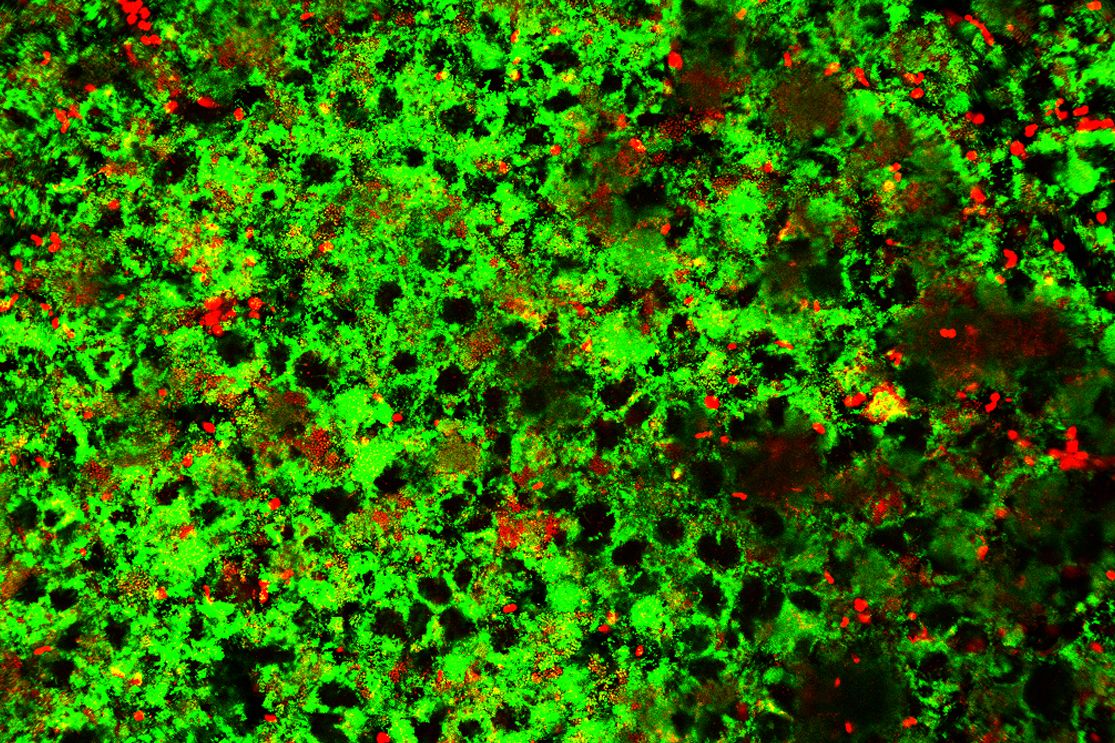We operate a state-of-the-art microbiological research laboratory in the research building adjacent to the clinic (safety level 2, Infection Protection Act).
Oral microbiology
Contact
frontend.sr-only_#{element.icon}: Dr. med. dent. Christiane von Ohle Acting Medical Director, head of research laboratory
frontend.sr-only_#{element.icon}: +49 7071 29-96418349
frontend.sr-only_#{element.icon}: 07071 29-4366
E-mail address: Christiane.von_Ohle@med.uni-tuebingen.de
Techniques and laboratory equipment
For our research work we have a variety of microbiological, molecular biological and microscopic techniques at our disposal, which enable us to isolate and identify germs
- microbiological cultivation,
- fluorescence in situ hybridization,
- mass spectrometry (MALDI-TOF),
- DNA extraction and sequencing
and conduct resistance testing.
The laboratory equipment includes
- a confocal laser scanning microscope (CLSM), which allows non-destructive, three-dimensional microscopic examinations of biofilms.
- a microprofiling system enables microsensor measurements of bacterial metabolic activities under online conditions.



Examination of the oral microbiome
Our current research focus is the study of the oral microbiome (which is the total of all microorganisms and bacteria present in the oral cavity) and its importance for oral health. We now know that a healthy microbiome is in balance with the host organism. However, if this balance is disturbed, we speak of dysbiosis. In this case, diseases such as caries, gingivitis and periodontitis can develop. There are far more than 700 different species of bacteria in the oral flora. These bacteria live in the oral cavity mainly in biofilms. Biofilms cover the tooth surface and protect the microorganisms from external influences, make communication between different types of bacteria (quorum sensing) possible, and make bacteria much more resistant to antibiotic treatment or antimicrobial rinsing solutions.



Development and investigation of the effectiveness of antimicrobial substances and oral hygiene products
Development and investigation of the
effectiveness of antimicrobial substances and oral hygiene products
Another research focus is the development and investigation of the efficacy of antimicrobial substances and oral hygiene products, which in clinical use can support the treatment of gingivitis and periodontitis in particular.

Material analyses for adhesion properties and their colonization with oral microorganisms
Material analyses for adhesion properties and their colonization with oral microorganisms
In addition, materials used in dental treatment, for example for fillings or implants, are analysed with regard to adhesion properties and their colonisation with oral microorganisms. We were able to develop complex preclinical biofilm models with different germ spectra (salivary microorganisms associated with periodontitis/periimplantitis, endodontic flora), which can be used for different indications.

AROB joint project

AROB joint project
Does the oral biofilm represent a reservoir for antibiotic-resistant germs and antibiotic resistance genes?
The AROB research project (Antibiotic Resistance in Oral Biofilms) is a unique research association of the Universities of Freiburg, Heidelberg and Tübingen in Germany. The aim is to investigate to what extent the microbial oral flora of healthy people, patients suffering from caries or periodontitis is a reservoir for antibiotic-resistant germs and antibiotic resistance genes. Against the background of an increasing development of bacterial resistance against the common antibiotics, the knowledge gained can be of importance beyond the field of dentistry.
Further links
Certificates and Associations

Focus: Top National Hospital 2025

Stern: Germany's Outstanding Employers in Nursing 24/25

Quality partnership with the PKV

Family as a success factor

Pension provision for the public sector





